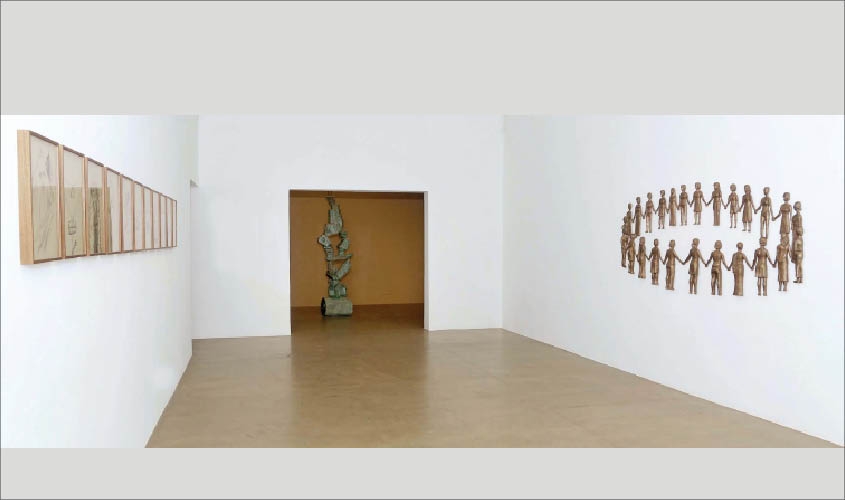A series of sculptures, drawings and videos created in recent years by artist Gigi Scaria is displayed at his ongoing solo show in Delhi. The artworks are steeped in symbolism and constitute a commentary on urban life, writes Bhumika Popli.
In his latest solo show, on view at Delhi’s Vadehra Art Gallery, artist Gigi Scaria seems to be saying, “You can have everything you want, but at what cost?” Entitled Ecce Homo: Behold the man or How One Become What One Is, the exhibition includes Scaria’s sculptures, drawings and videos all created in recent years.
The artist takes the name of the exhibition from the title of the final book written by the German philosopher Friedrich Nietzsche. The philosopher believed that a superhuman is one who has the ability to manoeuvre through all the challenges that life throws at him.
For this show, Scaria extends Nietzsche’s idea and shows the consequences a man could suffer in order to become superhuman after the Nietzschean model. He places his works under his preferred theme of the urban life and its effect on humans. Scaria looks at socio-political conditions in an urban context and offers a mix of serious and playful metaphors through his art.
Conviction is a set of three drawings by Scaria on display here. In one of these drawings, the artist refers, through the torso of a male figure, to the Hindu deity Hanuman, who, in keeping with mythology, has his chest split open. In the mythological version of this story, the image of Lord Ram resides in Hanuman’s heart, now ripped open for all to see. But in Scaria’s take, what we see inside the man’s heart is not Ram’s image, but flashing digital signs of play

In another of his artwork, which is a video entitled Disclaimer, a similar power structure is seen. “It was the news of lynchings that made me make this video,” says Scaria. In the nine-minute video, we see hands of a magician who is shown playing Three Cup Shuffle, a popular trick game where one places different objects under different bowls and the viewer has to judge the placement of the objects after the trickster shuffles the bowls. In another scene, there’s a village and several dead bodies. “I made the video in such a way that it seems it is the magician who is doing all these tricks,” says Scaria.
The sculptures are the most appealing of his artworks on display at the show. He has used classical figurative style in making these sculptures, which are small in size and are placed on the walls. “I knew that I wanted sculptures but on the walls of a gallery because it is the high-relief style that I really like,” says Scaria.
A fine example of Scaria’s mastery of this form is a bronze piece titled Ringa Ringa Roses. It depicts female figures holding hands while standing in a circle. “One can see the various perspective of the sculpture. I was making it more like a drawing with different standpoints. Now as we know that ‘Ringa Ringa Roses’ is used as a nursery rhyme but it has a dark history. It also refers to the plague in Europe which killed numerous people after World War II. For me, all these women are Indians belonging to different communities who are supporting each other in difficult times,” he says.

Scaria draws upon the narrative tradition of art history in his work. “One can find this narrative style in the paintings of acclaimed artists like Bhupen Khakhar, Sudhir Patwardhan and Gulam Mohammed Sheikh,” says the artist. Looking at the way Scaria places and designs sculptures, he comes across as a narrator who leaves his stories open-ended.
For instance, see another of his bronze sculptures, titled Human Pull. This artwork appears like a Dahi Handi scene often seen during Ganesh Visarjan in various parts of the country. The figure of a man on the top has one angelic wing attached to him, and there is no vessel for him to smash down. Scaria says, “Human beings do so much effort to reach the top but what if they find nothing at the top. They are sometimes just trying to grasp the emptiness. All these ideas are my own anxieties and my own personal issues which are actually reflecting through images.”
“How do you as an artist address those self-doubts and anxieties?” I ask him.
“You are probably apprehensive about what you are doing, especially in the arts. There is no fixed outcome. I think I address the issues with continuous work. There is always an element of self-critiquing and self-pitying, which are part of human nature. But the moment you are into such a creative process you are actually out of it all.”
The show is on view at Delhi’s Vadehra Art Gallery till 24 November

